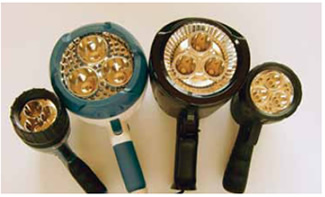
325
Testers in this month’s spotlight test evaluated a number of spotlight features. Although some points such as ergonomics involved a small degree of subjectivity, features such as brightness carried much heavier weighting in the final ratings. Here is what we looked at:
Ergonomics. Some models merely have an on–off switch; others add one or two controls to change power, or activate a strobe feature, or turn on a red beam. There were, however, as many configurations of use and meaning of the switches as there were spotlights. Testers concentrated on how these are used: Is one–hand operation possible? Are the controls logically placed? Do they snap into position, providing satisfying feedback? Can the light be turned on by accident, possibly leading to a depleted battery?
Beam Patterns. Rated power tells only a partial story: Where is the power radiated—into a spot, as desired? To evaluate beam pattern, we aimed each spotlight at the center of a four–foot-square segment of neutral-colored wall from 6 feet away, and photographed its beam patter to reveal the relative strengths of the spot, corona, flood, and spill portions. For maximum range, all of the light would radiate into the spot alone, and none elsewhere. To coincide with a two-foot–wide object such as a reflective patch on a life raft, at a fifth of a mile distance, a beam would have to start out at the reflector at about 1/10 of a degree wide—orders of magnitude smaller than the LED itself! Of course, none of the tested units could produce a beam this laser-narrow—nor would this be desirable. For spot beams of the same illuminance (lux), the narrowest will shine the same amount of light farther away. All beams, of course, aren’t of the same luminance, so we must also measure beam illuminance.
Beam Illuminance. Light actually reaching the target downrange is what counts, so for our second measurement, we used a Wavetek LM631 digital light meter to measure the lux value of light received from the spotlight at 30 feet. Higher lux values are better, but keep in mind the non–spot regions shown in the beam-pattern photos: They may be reflecting unwanted light back in your eye from lifelines, rigging, mast, boom, sails—anything on your boat between you and where the light leaves the boat.
Next, we turned to long-range performance, the area in which spotlights should really shine.
Beam Effectiveness at Distance. At dusk, a time we thought would challenge our vision more than full night, we set up a reflective target 1/5-mile away. The target was an 8-inch by 8-inch square of 3M Scotchlite SOLAS-A reflective tape (reported on in PS Chandlery, “A Shining Solution,” February 2006). While shining each spotlight on the target, the tester compared the brightness of the reflection in the target.
Service Time. This consisted of two time measurements: how long to half strength and how long to recharge. Our protocol is probably much more severe than the manufacturers’; we explain below. After a full recharge, or in the case of the Waypoint fresh C batteries, we switched the spotlight on at its highest-power setting, and started our timer. Every half an hour. We checked to see whether the light output had fallen to half its original output. When the light level had declined to half the starting value, we noted the elapsed time and terminated the test for that lamp.
We chose half power as a terminal value, not settling for a lower value because spotlights are specialized tools calling for high power, not general-purpose flashlights. Note that, at half power, the brightest spotlights still radiate more light than the low-power group does at initial full power.
After measuring service time, we returned the battery to a full charge and noted the time this took. Cycle times probably reveal something about battery types (there are at least five in this test) as well as individual capacity.
The number, depth, and length of service cycles have a great effect on battery behavior, so expect variations depending on your use.
Flashlight manufacturers reveal little about the batteries in their products, beyond type and (usually scan’t) charging instructions. In our experience, the lithium-ion batteries provide top performance and conventional lead acid batteries deliver the worst. But that extended life comes at a price. Our advice is to select your spotlight based on performance (light delivered to a distant target), and go with whatever battery type and charging protocol this entails. Because some batteries give no indication when they are reaching the end of their life, long-term cruisers will want to have a back-up or at least one spotlight that will work with the ship’s 12-volt system.
































